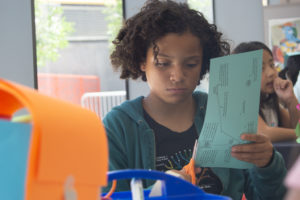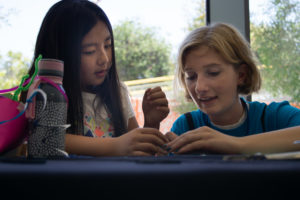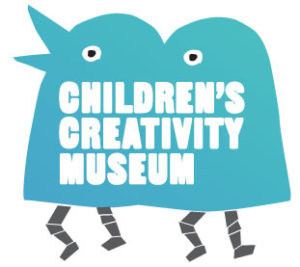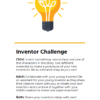![How can we support Girls in STEAM? How can we support Girls in STEAM? A Conversation between Kelly Reina and Leah Henry about CCM’s Girls in STEAM Camps K: Hello Leah! Let me start by introducing myself, my name is Kelly Reina and I, along with my wonderful co-lead Elizabeth Marcial, will be leading CCM’s Girls in STEAM Camp this summer. I’m […]](https://creativity.org/wp-content/uploads/2017/06/ANIMATION-Father_Daughter-e1499282491132.jpg)
How can we support Girls in STEAM?
A Conversation between Kelly Reina and Leah Henry about CCM’s Girls in STEAM Camps
K: Hello Leah! Let me start by introducing myself, my name is Kelly Reina and I, along with my wonderful co-lead Elizabeth Marcial, will be leading CCM’s Girls in STEAM Camp this summer. I’m very excited as this is a topic that I am passionate about! Some background about me: I came from scientific research (cognitive studies) and worked with nonhuman primates and children. After graduate school, moved to informal education, working at programing that were specifically STEAM focused. I arrived at CCM in January and am thrilled to promote STEAM education!
Now, you were at CCM for a few years, and during that time spent a great deal of your time as the lead on our Girls in STEAM initiatives. Can you tell me a little bit about that and what you’re up to now?
L: It’s true! I had the great joy of leading our Girls in STEAM efforts within the National Girls Collaborative Project. CCM runs the California Collaborative and acts as a liaison between girl serving organizations, schools, and families interested in empowering girls and young women through STEAM education. Through projects, opportunities, and community building, CCM and the National Girls Collaborative Project work to make STEAM fun and accessible to all! Since leaving CCM, I have shifted my efforts toward political organizing and public policy. I am dedicated to helping ensure we have more women in public service that are championing policies that directly help girls and women thrive.
K: Such a natural progression from CCM to political organizing! Now, We see a lot of organizations focus on STEAM (Science, Tech, Engineering, Art, and Math) but why is STEAM education especially important for young girls?
L: Great question, Kelly! As a backbone for learning in all fields, STEAM education offers a wonderfully complex and comprehensive system for students to engage their curiosities, practice new skills, and gain knowledge. STEAM education is primarily focused on the intersection of classroom studies and how to weave different topics together to make learning more dynamic and more relevant to each student’s interests. And with most STEM fields and careers advertised toward young boys and men, it is especially critical to encourage girls of all ages to explore the worlds of science, technology, and engineering, etc. The push to bring girls into the STEAM conversation not only helps level the playing field of opportunity, but also opens up new pathways and interests for girls that were previously discouraged. STEAM learning is fundamental to a student’s growth, as well as the future of innovation, and every child should have the opportunity to explore it, whether their gender has been “coded” for it or not.
K: In our Girls in STEAM camps we find that going on field trips to organizations outside of CCM is really beneficial for the girls. This summer, we are super excited about taking a trip to Women’s Audio Mission and to Cal Academy’s women-lead frog lab. What is the importance of visiting STEAM organizations during camp and when teaching STEAM?
L: Those trips sound amazing! Women’s Audio Mission is so cool. Visiting other organizations that are engaging with STEAM learning is definitely a perfect way to show how important STEAM remains in the real world. STEAM, as a broad umbrella of fields, is everywhere, but the connection is not always obvious to students. When students visit an organization that explicitly uses one or more fields of STEAM in their innovation/creation/product, students can observe the space and the people specifically through a STEAM lens. The girls instantly notice the connections to what they are learning in STEAM education, and likely have a renewed interest in their projects.
K: I agree completely. Which organizations did you visit?
L: In last year’s camp, we visited Autodesk, Creator, Girls Garage, and Edible Schoolyard, and hosted an educator from the Lawrence Hall of Science. Because the focus of the camp last year was on defining and imagining makerspaces, all four organizations were tied to the Makerspace Movement in some manner. The main purpose of visiting was to provide the campers examples and templates of what a makerspace can be, from a power tool workshop to a restaurant with a hamburger making robot, and inspire them to imagine all sorts of new ways to make and invent within makerspaces. To me, visiting organizations is all about providing inspiration, connecting concepts to the real world, demonstrating what their future interests and careers can be, and ultimately, having fun by going on field trips!
K: We are currently working on our projects for this years camp and are getting so excited about just how engaging STEAM curriculum can get. What projects did your campers do and why?
L: In 2018 we had a theme of Micro to Macro which was so fun. We started off using an Electronic Scanning Microscope and really explored the micro of things by analyzing nature objects. We went through projects about the Fibonacci sequence, camouflaging for biomes, community building storytelling prompts, paper-mechatronic bird making, discovering what blocks UV rays, building rockets, and making sunprints (just to name a few). We really focused on showing a practical side of really big (or really small!) concepts. Talk about the sheer power of the sun can be a bit overwhelming, so talking about it in relation to how a sun print is made is a bit more approachable and fun.
K: I imagine some of those concepts would definitely get complicated if you didn’t approach them in that way. It sounds like so much fun though! What aspect of camp did your campers like best?
L: In both the 2018 Micro to Macro STEAM CAMP and the 2019 Maker Space STEAM Camp I found that the girls just love making, in general, when the projects are engaging. I found myself really having to speed up my introductions because they would get so excited. Whether it was building rockets or collaborating with team-mates to decide what would be their ideal maker space, the girls were always ready to dive right in. It really shows you what can happen when you have a space that is engaging but is also a safe space where they know that the focus is on their ideas. It was wonderful to see that creative confidence.
K: We love to see that creative confidence blossom! Now, we all know that hindsight is 2020. What part of camp would you have changed?
L: I have learned that it is especially important to intentionally bring fun and games into the community space when the group is tasked with a big project. During our Maker Camp, because we were so excited by teaching so many things, I don’t believe we left enough time or made enough room for goofing off and playing games that year. Of course, it wasn’t a disastrous lack of fun, as all the girls definitely had quite a bit of fun, but the lack of specific times every day allotted to fun & exploratory play (where there is no end goal) is really important in processing those concepts that we were teaching.
K: That’s such a great point. It’s easy to forget to schedule that decompression time, which is just as important. In addition to that imperative fun, CCM always puts such a huge emphasis on sharing out at the end of an activity. Did you also include time to share after learning some of those fun concepts? What do you think is the best way to promote openness and discussion with young girls?
L: Definitely. Part of every activity was a chance for the Girls to ask questions and to collaboratively guide a dialogue amongst themselves about what they were learning. In my experience, young girls are the best leaders of their own discussions and self reflections. As educators, we can pose questions and act as moderators as girls will fill in the space with their thoughts and ideas rather quickly if we give them the time to do so. It is natural to want to share your perspective and experience, and young girls very rarely have the opportunity to do so in a comfortable and affirming environment. Experiences like Girls in STEAM camp is precisely the place for young girls to be open and honest with each other and the educators in their lives.
What are the big 3 takeaways from STEAM Camp for the campers?
Stay Curious: Build on the knowledge you already have to find new skills and ways of learning! Don’t be scared of what you don’t know, or that something may be hard at first. Everything worthwhile is scary at first.
Collaborate: Make sure you are including others as you discover, learn, and grow. STEAM exploration is way more exciting when you have peers to help you. Find the elements of STEM learning that you find especially fun, and share them with others!
Find the fun: STEAM is all about fun! Even when experiments or projects get frustrating, there is fun waiting right around the corner. If something is getting difficult, step back and reflect on why and what you could change to make it better.
K: Those seem like lessons we could all live by! How can they take lessons from camp and apply them in real life?
L: Most likely, what campers are learning day to day at camp will run in tandem to what they are learning during the school year, and hopefully any extracurriculars they are participating in. The best way for campers to quickly make these connections is for educators to prompt that reflection in the moment that they are excited by a new project, concept, or idea they have just learned. Reflection and brainstorming the connection and application will help build that bridge between the conceptual to the tangible.
K: Alright Leah, thank you so much for chatting with us. It’s been wonderful to hear your reflections on CCM’s STEAM Camps and how we can support Girls in STEAM.
I have one more for you: With all of the inequality in STEAM, how do we promote hope for young girls?
L: Through camps like Girls in STEAM! The more that girls see other girls, their peers, engaging with STEAM in a fun and meaningful way, the more motivated they will be to jump into it and stick with it, even when the learning gets frustrating. Experiences like CCM’s Girls in STEAM camp provide the encouraging environment girls need to practice new skills, gain confidence in themselves, and be emboldened to continue learning right alongside their male classmates. As we know, girls can do anything they put their mind to – they just need the space, time, and support to do it!
k: So true. Well, we’re so excited to continue to support that type of STEAM learning in our programming at Children’s creativity museum and especially our Girls in STEAM Camp this summer. Thanks for joining us Leah!
If you’d like to learn more about signing up for our Girls in STEAM camp, head over to Creativity.org!






Leave a Reply